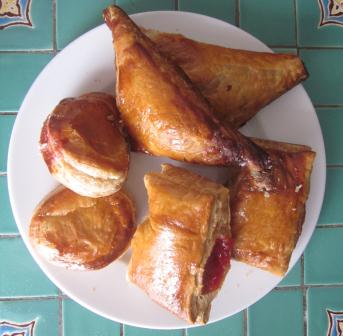Pastelito de Guayaba, Guayaba y Queso, Coco y Carne
The summer before sixth grade, we moved to the Los Angeles, California, suburb of Bell. The local Spanish Assemblies of God church, the denomination where my parents were credentialed, was across the street from the apartment we moved to; and the church was pastored by a wonderful Mexican couple, Rev. and Mrs. Pablo Torres, who had been missionaries in Cuba, and knew my parents from the days they had all lived on the island.
I had been introduced to Mexican food, which I love, long before moving to California; but it was in that church, with the many social events that were always incased with the aromas of homemade Mexican food, that I learned to appreciate one of the world’s most remarkable cuisines. However, Bell also gave me my first Cuban bakery.
From our apartment, I could not only walk to church and school, but up to the post office, and on to the Cuban bakery to buy Cuban bread, crackers, croquettes, special canned goods, meats, and pastries – it was an all-purpose stop for Cuban foods, which at the time were rather difficult to find in California, or anywhere else outside of New Jersey or Florida.
It was my father who of course found the bakery and would for years after we left the area, continue to go back and bring home bags filled with Cuban delights. It was always such a thrill to open the packages he would bring home and pour over his picks for the day, week, or month, depending on the budget.
It would not be until I moved to South Florida, that I would once again find the abundance of Cuban treats that we had known in Bell; and much to my surprise, I would find them at the local grocery stores. It was quite some time before I would quit marveling at the surprise of finding Cuban bread housed next to Jewish Rye or a French baguette; and though I have grown to accept that Publix (Southern grocery store chain) makes Cuban pastries, I was not prepared to find guava pastries from Entenmann’s!
Yesterday, I ran into a Market Basket, a grocery store, in Andover Massachusetts; I was on my way to the hospital, to see my Mother, and thought I would pick up some cheese, for her snack. I easily found my way to the Entenmann’s end cap, wondering if they had my black and white cookies or Kate’s cheese Danish – neither were present, but much to my surprise, they had guava pastries!
Guava pastries or pastelito de guayaba, have long been a favorite treat in Cuban, Cuban-American, or those close to a Cuban household. The stuffed puff pastries are airy, flaky pockets of paste from guavas, the most delicious of all tropical fruits, which are baked and glazed to perfection. The same dough can be filled with seasoned ground beef, coconut, or guava and cream cheese. I highly recommend all of them.
My favorites are guava and meat, while Kate prefers guava with cheese. These are actually quite easy to make. I do not make my own puff pastry, though I have in the past and if you have the time and counter space, I promise you will not be disappointed. Pepperidge Farm’s puff pastry is one of my freezer staples, and what I normally use to make these mouth-watering treats.
Though I usually share my own recipes here, I have decided that I cannot top what Three Guys from Miami: http://icuban.com/food/pastelitos.html have laid out for their readers. Their step-by-step directions, including how to make the puff pastry are perfect. However, I am also including my recipe for Picadillo, a ground meat staple in Cuban food, which I use when making the meat pastries. If using this recipe for the pastries, you will want to make sure the filling is on the dry side, and that you do not overfill the round dough cut outs. If you want to make Picadillo for dinner – saucy is best!
By the way, traditionally, guava and coconut pastries are square, meat filled are round, and the more traditional triangle turnover shape is for guava and cheese.
Picadillo
This is very basic Cuban fare, served with white rice, fried plantains (maduros), with black beans being optional, but preferred. I make mine with cilantro, which most people do not use, and I add the dried plums and a touch of hot peppers. Also, I would probably add a bit more cumin and oregano, but I would say the measures below are a good start, and you can increase flavors according to your palate. Picadillo is also used to describe ground beef dishes in other Latin American countries, though the recipes differ from the Cuban dish.
Ingredients:
1 pound of Ground Beef
1 large Onion
2 tablespoons of Garlic
1 small Bell Pepper
¼ of a Hot Pepper – you can do this to taste
Green Olives, stuffed with pimentos, approximately 20
Capers 2 tablespoons
Oregano 2 tablespoons
Cumin 1-2 tablespoons
Cilantro ½ a bunch, chopped
Bay Leaves 2
Dried Plums 6-8 coarsely chopped
Raisins ¼ cup
1 small can of Tomato Sauce
2 tablespoons of white vinegar
1 teaspoon of sugar
Red Wine ½ cup of wine
Olive Oil
Directions:
Brown the beef, add onions, garlic, and peppers. Add the rest of the ingredients and if needed, up to a cup of water. Bring the picadillo to a boil, and then lower the heat to simmer, for at least thirty minutes, adding more water or wine if needed. Some people prefer the dish dry, I like it saucier. Taste as you go along, and see what suites you.











